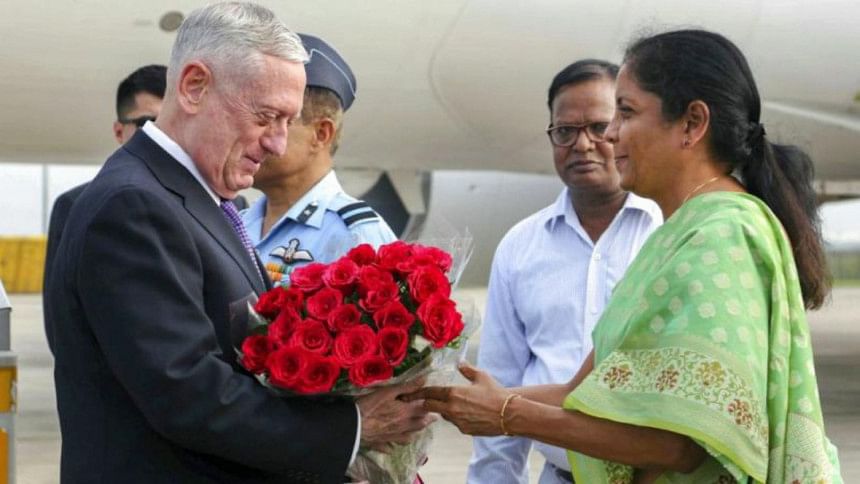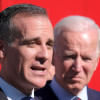US-India relations reach 'unprecedented heights'

Soon after the signing of the Communications Compatibility and Security Agreement (COMCASA) with her American counterpart James Mattis in New Delhi on September 6, Indian Defence Minister Nirmala Sitharaman termed the deal as elevating bilateral ties to "unprecedented heights."
She is absolutely right. For the agreement pushed India into a never-before-seen strategic embrace of the US because it will allow exchange of the communications through systems mounted on the weapons systems of the two countries' militaries. The agreement came after US Secretary of State Mike Pompeo, India's Foreign Minister Sushma Swaraj, India's Defence Minister Nirmala Sitharaman and US Secretary of Defence James Mattis came together in what represented the highest level of political engagement between India and the US.
The COMCASA undoubtedly marked the most aggressive push towards elevating the Indo-US strategic partnership. History shows the US has always found it easier to forge close defence and strategic ties with right-wing governments in Third World countries and India is no exception. It was Atal Bihari Vajpayee as prime minister who had termed the US as a "natural ally" of India almost two decades ago. His decision to test nuclear devices in May 1998 paved the way for negotiations on the Indo-US civil nuclear deal during the BJP government's tenure. It was taken forward by the Congress Party government headed by Manmohan Singh, who is known for his centre-of-the-right tilt in Congress and the agreement signed in 2008.
It is not a coincidence that two of the three foundational military agreements the US wanted India to sign were finalised during the reign of the government of Prime Minister Narendra Modi. In August 2016, the two countries signed the Logistics Exchange Memorandum of Agreement (LEMOA) which allows the military of the US to support defence operations out of India. And now comes the COMCASA that opens up sensitive military communications between the two countries, pushing the boundaries of strategic cooperation. The third agreement on which talks are yet to begin is the Basic Exchange and Cooperation for Geo-Spatial Cooperation (BECA).
The signing of the COMCASA and the LEMOA has seen India come a long way since shedding the baggage of history of a prolonged anti-US mindset during the Cold War period when New Delhi was tied to Moscow in terms of cooperation agreement and source of military hardware and nuclear power. India's overwhelming dependence on Russia remains by and large intact today. In fact, India is looking to wrap up a deal to buy air defence system from Russia at a cost of USD 6 billion notwithstanding the threat of American sanctions on import of arms from that country under the Countering America's Adversaries Through Sanctions Act (CAATSA).
In the last four years, the Modi government had for the most part given the impression of pursuing a policy of multi-polarity in international politics, which many consider as a reincarnation of the policy of non-alignment seen during the Cold War years, through its decision to purchase air defence system from Russia, its move to enlist the support of a Russian entity for the Indian Navy's submarine project, going ahead with the construction of the strategic key port of Chabahar in southern Iran, and import of crude oil from the Persian Gulf country braving the looming American sanctions which are set to kick in on November 4. Modi has time and again described Russia as a "time-tested friend" of India. Besides, he also reached out to China by meeting Chinese President Xi Jinping a number of times in the last four years.
But the signing of the COMCASA has given an unprecedented pro-US tilt to India's foreign policy. The US, for its part, ensnared India into the COMCASA by designating the latter as a major defence partner in 2016.
However, it may not be easy for India to overcome the past hangover of suspicion. It has been argued by some that the COMCASA is a measure of India's readiness for transactional diplomacy the US is so adept at. But where is the transaction? For instance, international experts like Brahma Chellaney are asking what India has got in return for the COMCASA. And he has a reason to do so because the US is yet to accede to India's request for waiving sanctions for purchasing the air defence system from Russia or continuing to source Iranian crude. And there still hasn't been any resolution of the tariff dispute on the imposition of US import duty on steel and aluminium from India.
Another strategic affairs analyst Bharat Karnad pointed out in a newspaper article how past American actions have not generated much confidence about the conduct of its strategic ties with India. He said that in 1982 the US had tipped off Pakistan about a possible joint India-Israel mission against Pakistani nuclear weapons; in 1998 the US disclosed to China the content of a note from Vajpayee to then American President Bill Clinton justifying India's nuclear test in response to the Chinese threat; and in 2008 Washington failed to alert India about the deadly attacks in Mumbai in November that year by terrorists from Pakistan.
Indian media is full of reports that the US has sought to address the concerns in India over how secure the information-sharing between the two militaries under the COMCASA will be. There is acknowledgement in India that the COMCASA will expose Indian military's communication data to the US. The question is: how iron-clad are the assurances given by the US in response to India's concerns? If Indian media reports are anything to go by, either side can abrogate the COMCASA by giving six months' notice in advance. But the question remains: what happens to information already gleaned before abrogation? In fact, such a possibility may work against the termination of the COMCASA. It also remains to be seen how Russia reacts to the COMCASA. Will it impinge on procurement of weapons from Russia?
India reportedly opted for the COMCASA keeping primarily China in mind so that it can help track movement of Chinese military along the unsettled border in the Himalayas (the Doklam standoff last year was seen as a trigger for the COMCASA) and keep a tab on Beijing's increasing naval presence in the Indian Ocean. To sum it up, the COMCASA has pushed the envelope of India's foreign policy further than ever before.
Pallab Bhattacharya is a special correspondent to The Daily Star.










Comments